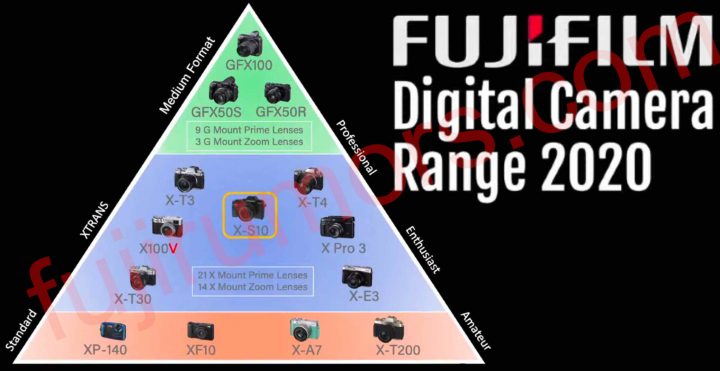Fujifilm Digital Camera Range: Making Sense of the Line-Up, What Should be Dropped, What Should Stay… and Where is the X-H Line?

I already said it in my X-S10, Attack on Sony article: the Fujifilm X-S10 makes a whole lot of sense.
And yet, I do understand one of the critiques made to Fujifilm: their line-up is huge and potentially confusing.
There are indeed some lines, that in some occasions do not not differentiated themselves enough from each other.
But this is an issue Fujifilm realized and I feel that they are taking care of it, for example:
- the Fujifilm X-Pro3 is a unique machine, with a concept, so far nowhere to find
- Fujifilm is aware that the the Fujifilm X-H2 must differentiate stronger from the X-T* line in order to continue to evolve separately
Fujifilm understands the problem and is finding ways to separate the lines better.
And yet… there are some lines that should be dropped, in my opinion.
Let’s take a look it at, by using an official Fujifilm media sheet that has been sent to me, which shows a pyramid with all Fujifilm X series cameras listed and ordered by Fujifilm itself.
The Red Zone
The incredible magic of the X-A line, undisputable King over all other camera brands in some countries, seems to be gone, probably fallen victim to smartphones. Fujifilm outsourced its development to the Xacti corporation in 2017, and I believe it could just give up on that line completely.
There is the lovely Fujifilm X-T200, arguably the best entry level camera you can buy. It has a viewfinder, which radically sets it apart from the “smartphone-experience”. This is a camera I’d wholeheartedly recommended to anybody, who needs a small and very affordable camera to take better family or travel photos than with their smartphones. But in the long run I do not see any entry level camera survive with dignity in the camera market, and I’d recommend Fujifilm to drop it. By the way, also this one is developed by Xacti Corporation.
The XF10 failed badly. It’s major flaw? It was not an X80. If Fujifilm is serious with this line, they can keep it up. But if they plan XF20 or so, they better drop that line, too.
And the XP140? Well, with smartphones getting tougher, water resistant and what not, I don’t see a future in this line, either.
CONCLUSION: the bottom of the pyramid could be totally dropped.
The Blue Zone
If you’ve read my “attack on Sony” article, you’ll understand that I believe all cameras in the blue zone make sense and have a reason to exist.
And yet, I doubt they will all continue.
In the “Blue Zone”, Fujifilm should continue to develop only those camera lines, that also have some decent return of investment.
The Fujifilm X-E line will get one more glorious iteration, the rumored Fujifilm X-E4. But if also that one does not sell properly, I am afraid it could be the end of the X-E line. You know I love the X-E cameras, but we also have to be realistic: if something does not sell, then there is no point in continue to invest money into it.
As for the X-T30 and X-S10, they both could co-exist, as they are different enough in my opinion. But also here I think that only the one that will sell stronger will continue to exist. Hard to say which one will sell better.
Fujifilm is doing everything right with the X-Pro line, by totally focusing on delivering a unique and different photographic experience rather than running after specs. That line is here to stay, but continue with its slower refresh cycle of around 4 years.
The X100 line on the other hand is navigating in safe waters with it’s fixed lens concept and extremely sexy look. It is and will always remain a best seller for Fujifilm.
And now to the big one: X-T or X-H?
If you look at the pyramid shared by Fujifilm, the X-H line is completely missing. But don’t worry, as we always and consistently told you, there will be a Fujfiilm X-H2. Fujifilm managers confirmed it multiple times, too. The latest statement by a Manager was that the Fujifilm X-H2 needs to feature breakthrough technology. Being high-end cameras, I believe there is room for both, the X-T* and the X-H* line, if Fujifilm manages to differenciate them enough.
The Green Zone
The more time passes, the more I am convinced of what I wrote a while back: the Fujifilm GFX is future proof!
In fact, I think the Fujifilm GFX has a terrific potential and will be the one mirrorless system to profit most from future technology, for the reasons I explained here.
The next rumored and soon coming Fujifilm GFX100 camera already sounds promising. And it will just get better and better over the next months and years.
The only real threat could come if other camera brands decide to enter the same mirrorless medium format market. But most of them are busy fighting a brutal battle in the full frame market, that I am not sure anything like a serious GFX competitor will hit the market anytime soon. Although, quite frankly, I do hope that one day some company would bring the mirroreless battle also the medium format system, as it’s a proven fact that we customers profit from competition. Sony? Canon? Anyone?
Until then, the Fujifilm GFX will continue its undisturbed rise to camera world domination! ;)
Any you?
And what about you? What are your thoughts on the Fujifilm line-up? Feel free to join the discussion in the comments down below.
Join Our Owners Groups
- Fujifilm GFX User Group
- Fujifilm X-T User Group
- Fujifilm X-S10 Group
- Fujifilm X-H User Group
- Fujifilm X-E User Group
- Fujifilm X-Pro User Group
- Fujifilm X100 line Group
Join Our Facebook Pages

